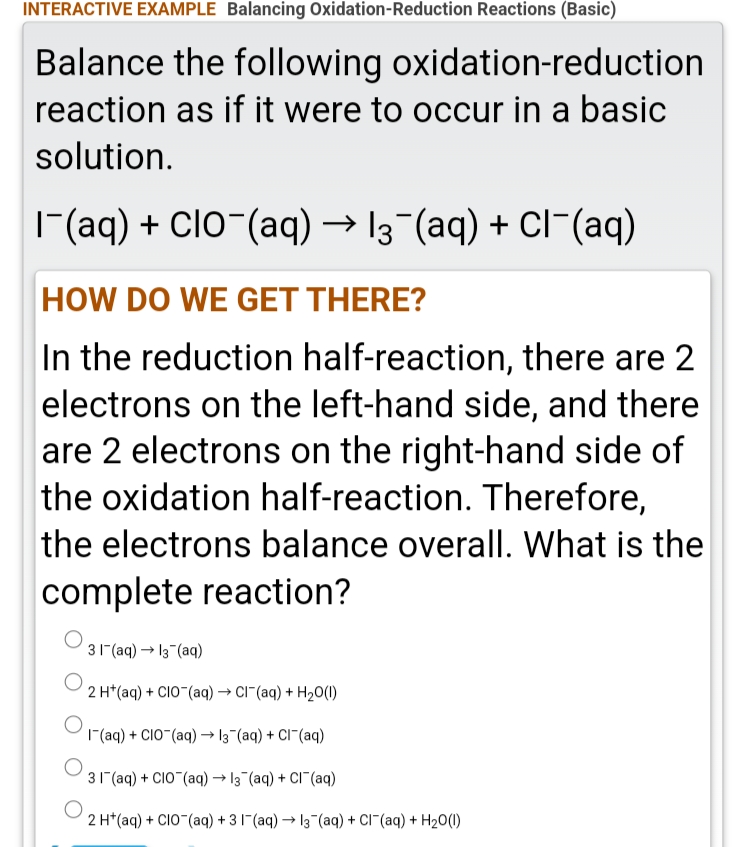Balance the following oxidation-reduction reaction as if it were to occur in a basic solution. |(aq) + Clo-(aq) → 13¬(aq) + Cl(aq) HOW DO WE GET THERE? In the reduction half-reaction, there are 2 electrons on the left-hand side, and there are 2 electrons on the right-hand side of the oxidation half-reaction. Therefore, the electrons balance overall. What is the complete reaction? 31"(aq) → 13"(aq) 2 H*(aq) + CIO (aq) → CI"(aq) + H20(1) |(aq) + CIO (aq) → 13 (aq) + CI (aq) 31(ag) + CIOlag) - lelag) + CIlag)
Balance the following oxidation-reduction reaction as if it were to occur in a basic solution. |(aq) + Clo-(aq) → 13¬(aq) + Cl(aq) HOW DO WE GET THERE? In the reduction half-reaction, there are 2 electrons on the left-hand side, and there are 2 electrons on the right-hand side of the oxidation half-reaction. Therefore, the electrons balance overall. What is the complete reaction? 31"(aq) → 13"(aq) 2 H*(aq) + CIO (aq) → CI"(aq) + H20(1) |(aq) + CIO (aq) → 13 (aq) + CI (aq) 31(ag) + CIOlag) - lelag) + CIlag)
Chemistry: The Molecular Science
5th Edition
ISBN:9781285199047
Author:John W. Moore, Conrad L. Stanitski
Publisher:John W. Moore, Conrad L. Stanitski
Chapter17: Electrochemistry And Its Applications
Section17.3: Voltaic Cells
Problem 17.3PSP
Related questions
Question

Transcribed Image Text:INTERACTIVE EXAMPLE Balancing Oxidation-Reduction Reactions (Basic)
Balance the following oxidation-reduction
reaction as if it were to occur in a basic
solution.
|(aq) + Clo-(aq) → 13-(aq) + Cl¯(aq)
HOW DO WE GET THERE?
In the reduction half-reaction, there are 2
electrons on the left-hand side, and there
are 2 electrons on the right-hand side of
the oxidation half-reaction. Therefore,
the electrons balance overall. What is the
complete reaction?
31"(aq) → 13 (aq)
2 H*(aq) + CIO (aq) → CI"(aq) + H20(1)
| (aq) + CIO"(aq) → 13 (aq) + CI¯(aq)
31 (aq) + CIO (aq) → 13 (aq) + CI (aq)
2 H*(aq) + CIO-(aq) + 31"(aq) → 13-(aq) + CI¯(aq) + H20(1)
Expert Solution
This question has been solved!
Explore an expertly crafted, step-by-step solution for a thorough understanding of key concepts.
Step by step
Solved in 2 steps with 2 images

Knowledge Booster
Learn more about
Need a deep-dive on the concept behind this application? Look no further. Learn more about this topic, chemistry and related others by exploring similar questions and additional content below.Recommended textbooks for you

Chemistry: The Molecular Science
Chemistry
ISBN:
9781285199047
Author:
John W. Moore, Conrad L. Stanitski
Publisher:
Cengage Learning


Chemistry: Principles and Practice
Chemistry
ISBN:
9780534420123
Author:
Daniel L. Reger, Scott R. Goode, David W. Ball, Edward Mercer
Publisher:
Cengage Learning

Chemistry: The Molecular Science
Chemistry
ISBN:
9781285199047
Author:
John W. Moore, Conrad L. Stanitski
Publisher:
Cengage Learning


Chemistry: Principles and Practice
Chemistry
ISBN:
9780534420123
Author:
Daniel L. Reger, Scott R. Goode, David W. Ball, Edward Mercer
Publisher:
Cengage Learning

Chemistry & Chemical Reactivity
Chemistry
ISBN:
9781133949640
Author:
John C. Kotz, Paul M. Treichel, John Townsend, David Treichel
Publisher:
Cengage Learning

Chemistry & Chemical Reactivity
Chemistry
ISBN:
9781337399074
Author:
John C. Kotz, Paul M. Treichel, John Townsend, David Treichel
Publisher:
Cengage Learning

Chemistry: Principles and Reactions
Chemistry
ISBN:
9781305079373
Author:
William L. Masterton, Cecile N. Hurley
Publisher:
Cengage Learning